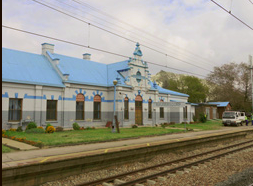
The building, with its richly decorated gable, was completed in 1896 and is one of the last surviving structures of the old Transvaal railway system. It was declared a National Monument in 1983, devolved to a Gauteng Provincial Heritage Resource in 1999. [SAHRIS] Construction also began in 1895 on two other important station buildings of the Rand Tram, Krugersdorp and Jeppe. The former was destined to have a more permanent character than Johannesburg's Park Station. The original Krugersdorp station building was a standard corrugated iron structure (a Type II building) with a hipped roof and a verandah. In July 1895 construction of the South-Western Line to Klerksdorp commenced at Krugersdorp, and simultaneously work started on the erection of a much larger and more sophisticated building. The old one would have been inadequate for a station like Krugersdorp, being the terminus of two railway lines, namely the Rand Tram and the Klerksdorp line. The new station building, completed in 1896, was erected by the well-known building contractor MCA MEISCHKE, who built numerous stations and cottages for the NZASM. The new building at Krugersdorp stood isolated on higher ground South-West of the town, close to the mining area, and was built according to NZASM designs. Originally the red brick structure was decorated with stonework in the form of two horizontal bands, cornices and voussoirs at window and door arches. The most striking feature is the imposing Neo-Dutch Renaissance gable situated above the main entrance and forming part of the street facade. The platform side had no gable, only a lean-to canopy. After 1900 the building was extended lengthwise and sadly all exterior wall surfaces (with the exception of the platform side) were plastered and painted, resulting in the edifice losing much of its original Dutch character. Krugerdorp's station building, one of the remaining architectural gems of the NZASM, still exists, although it no longer serves its original purpose.